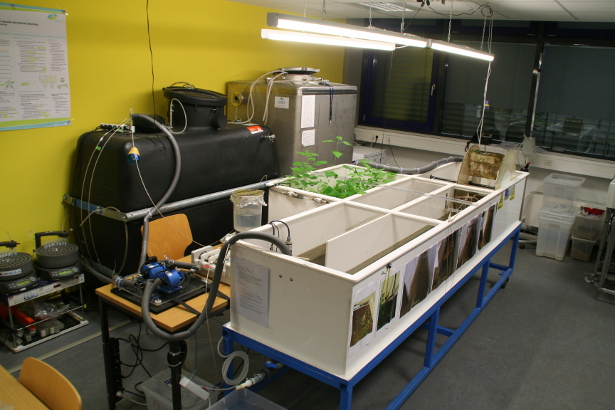In this new series of posts we present you some of the equipment and facilities we use to assess the fate and environmental impacts of chemical stressors. This time Sandra Kurtz, Dr.-Ing. George, and Prof. Dr. Schaumann present the Laboratory floodplain mesocosm system.

Floodplain mesocosm facility (photo by G. Metreveli)
The working group Environmental and Soil Chemistry presents you the newly designed floodplain mesocosm system which is used to assess the fate, distribution and biological effects of engineered inorganic nanoparticles (EINP) in aquatic-terrestrial transition zone.
The mesocosm system consists of a main channel, permanently flooded zone and a soil zone (floodplain area). The main channel includes sand as sediment (5 cm high) and an aquatic phase with 375 L water from the River Rhine. Furthermore, a circulating water flow (0.03 m s– 1) is provided through a paddle wheel in the main channel. The Floodplain area representing the meadow contains soil from an adjacent Rhine floodplain. The soil zone can be flooded at higher water levels like a natural meadow. The soil columns located in the floodplain area as well as in the permanently flooded zone.
The experiment starts with an equilibration phase of 2 months followed by a control phase of two weeks. Flooding events with a duration of five days are simulated every three weeks. The duration of the experiment is 33 weeks. Nanoparticles (silver or titanium dioxide nanoparticles) with a concentration of 5 mg L– 1 are continuously introduced into the aquatic phase for three weeks (0.5 mL min– 1), followed by a three-week period without spiking. Every third week, the ecotoxicological impact of EINP is determined by means of Gammarus fossarum feeding assays. The first findings of the mesocosm study show that the floodplain mesocosm system is a promising tool for the simulation of natural events and for the evaluation of the distribution, fate, and long-term effects of EINP in aquatic-terrestrial transition zone.
The mesocosm system is running within the ongoing research unit INTERNANO (FOR 1536) funded by the German Research Foundation (DFG). All subprojects of INTERNANO (MASK, SOILMOBILE, PORESURFACE, PORENET, IMPACT and BIOFILM) are working together on one system to assess the pathway and effects of nanoparticles in aquatic and terrestrial ecosystems.
